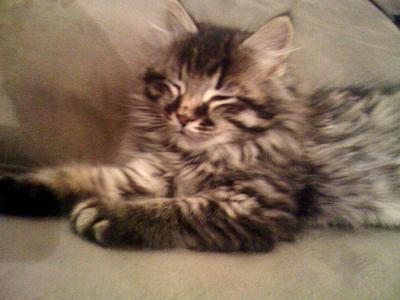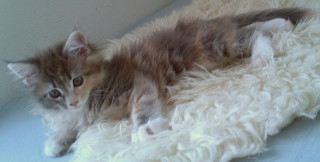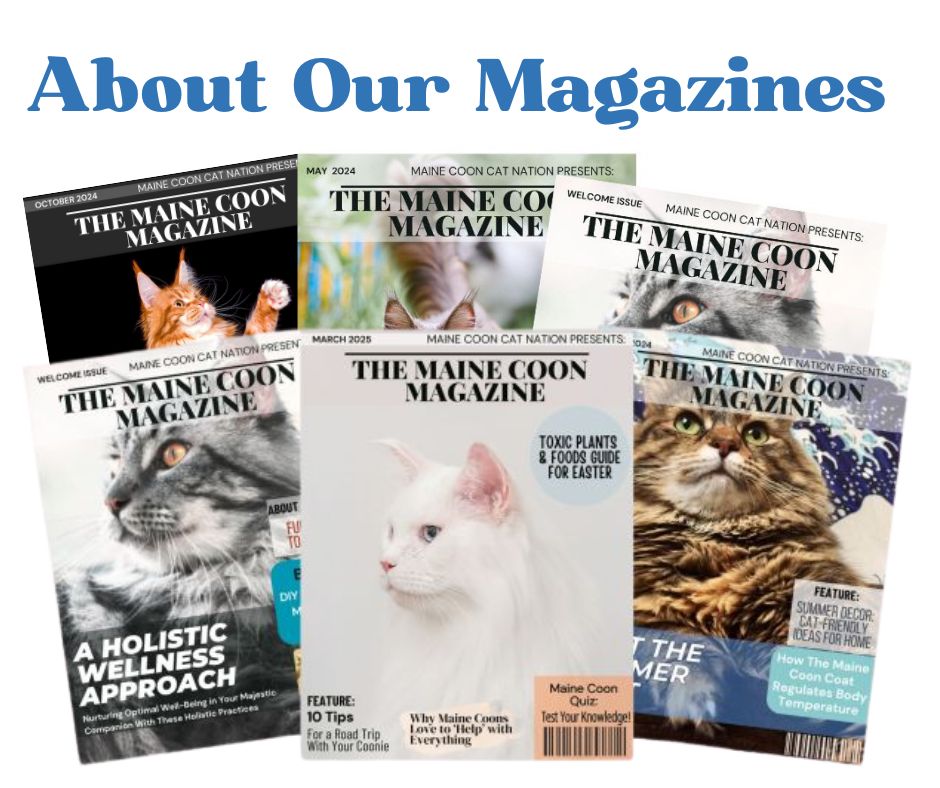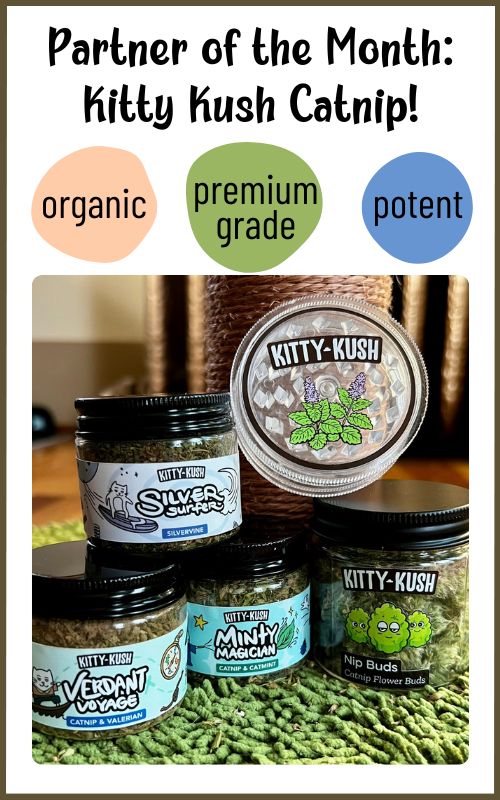- Home
- Maine Coon Cat Health
- Foods For Diarrhea
Best Kitten Food For Diarrhea: Simple Diet Tweaks to Soothe an Upset Stomach
When you bring home your new kitten, he or she is going through a lot of changes. Diet might be changing, a journey might have been completed, and of course there’s an entirely new environment to adjust to.
If your new furbaby has diarrhea, there are definitely some different foods and supplements to try!
The best kitten food for diarrhea depends on the cause, but in general, you want something that is gentle on the stomach, highly digestible, and low in fat while still providing enough nutrients for their growth.
Best Foods for Kittens with Diarrhea
Here are 4 helpful foods to try:
1. Boiled Chicken & Rice (Temporary Diet)
If the diarrhea is mild and you suspect a food-related issue, a short-term diet of plain boiled chicken (shredded) with a little plain white rice can help firm up the stool.
Boiled chicken and rice can definitely look a little dry, but there are ways to make it more kitten-friendly.
How to Prepare Boiled Chicken & Rice for a Kitten with Diarrhea
Ingredients:
- Boneless, skinless chicken breast (no seasonings, oils, or butter)
- Plain white rice (not brown rice - it’s harder to digest)
- Water (to moisten the meal)
Steps:
- Boil the Chicken: Place the chicken breast in a pot of water and boil until fully cooked (about 15-20 minutes).
- Cook the Rice: Use the same water you boiled the chicken in to cook the rice. This adds some flavor and makes it easier to digest. Cook it soft, so it's easy to mash.
- Shred the Chicken: Once cooled, shred the chicken into very small, kitten-sized bites - about the size of their dry kibble or smaller. If they’re very tiny, you can mash it slightly.
- Mix with Rice: Start with a 2:1 ratio of chicken to rice (more chicken than rice). If the she accepts it well, you can adjust as needed.
- Moisten the Mixture: Add a little bit of warm, unsalted chicken broth (or just the cooking water from the chicken) to make it softer and easier to eat. You don’t want it soupy, just lightly moistened.

Feeding Tips:
- Serve small amounts frequently (4-6 small meals a day).
- Always ensure the kitten has access to fresh water or even unflavored Pedialyte to prevent dehydration.
- This is a temporary diet (1-3 days max). Once stools start firming up, transition slowly back to their regular kitten food by mixing it in gradually.
2. Pumpkin or Sweet Potato
A tiny bit of plain canned pumpkin (not pie filling) or cooked sweet potato can help regulate digestion due to its fiber content.
Some brands of pumpkin pie filling are sneaky - they look like they're just pumpkin, but much of the time, they contain added spices, sugar, and sometimes even thickeners like cornstarch.
However, if you’ve found a brand where the ingredients list only says "pumpkin" and nothing else, then it’s essentially the same as plain canned pumpkin and would be safe to use.
To double-check:
✅ Plain canned pumpkin should list just "pumpkin" as the sole ingredient.
⚠️ Pumpkin pie filling often includes cinnamon, nutmeg, sugar, and other additives, which aren't safe for kittens.
- Start with ¼ to ½ teaspoon mixed into their wet food.
- Give once or twice daily (morning and evening).
If the kitten tolerates it well, you can increase to 1 teaspoon per meal, but don't overdo it.
How Long to Give It?
- Use for 1-3 days until stools firm up.
- If diarrhea persists beyond 2-3 days or worsens, stop and reassess (could be a food issue or something needing vet attention).
Is Fiber OK?
"I always thought that fiber 'made' the body poop. why would you add fiber if a body is pooping too much?"
It seems counterintuitive, but not all fiber works the same way. The key is soluble fiber vs. insoluble fiber:
How Fiber Helps with Diarrhea
Pumpkin is high in soluble fiber, which absorbs excess water in the intestines and slows down digestion. This helps firm up loose stools.
✔ Soluble fiber (like in pumpkin) → Absorbs excess liquid → Forms a soft, gel-like consistency → Slows down diarrhea
✔ Insoluble fiber (like in leafy greens, bran) → Adds bulk and speeds up digestion → Can worsen diarrhea
Why Does This Work?
When a kitten has diarrhea, their intestines are moving food too quickly. Soluble fiber soaks up extra liquid and gives the gut more time to absorb nutrients, leading to firmer stools.
Other Soluble Fiber Sources That Work Similarly:
- Plain mashed sweet potato (just a tiny bit)
- Cooked plain oats (a small amount mixed in food)
- Unflavored psyllium husk powder (tiny pinch)
So, it’s all about the type of fiber!

3. High-Quality, Limited-Ingredient Wet Food
If they're on regular kitten food, switching to a bland, high-protein wet food with fewer additives can help. Look for simple, high-meat-content options.
Switching foods during a stressful transition can actually make diarrhea worse, so if a kitten is already eating a decent quality food, it’s usually best to stick with it until they’ve fully adjusted to their new home.
When Would Switching to a Limited-Ingredient Food Be a Good Idea?
This recommendation is mainly for situations where:
✔ The breeder’s food isn’t available or suitable: Some breeders feed raw, homemade, or lower-quality foods, and new owners might need to switch.
✔ The kitten already has ongoing digestive issues: If diarrhea persists beyond a day or two and the original diet seems to be part of the problem, a simpler, high-quality food can be easier on their system.
✔ Suspected food intolerance or sensitivity: Some kittens don’t do well with common fillers, artificial additives, or too many ingredients.
If You Must Change Foods, What’s the Best Approach?
- Gradual Transition: Mix the old food with the new over 5-7 days to prevent further stomach upset.
- Simple, High-Meat, Low-Filler Foods: Look for options with limited ingredients (avoiding grains, artificial additives, and too many proteins at once).
Best Types of Wet Food for Sensitive Tummies
- Tiki Cat Pate (Chicken or Turkey): Limited-ingredient, high-protein.
- Weruva Kitten (Chicken or Turkey): Gentle on digestion, no fillers.
- Instinct Kitten Pate: High-quality, simple ingredients.
But again, if the kitten is already on a good food and adjusting well, keeping them on it is the best course of action.

4. Kitten Probiotic Paste or Powder
Not exactly a food, but adding a kitten-specific probiotic to their meals (like Purina FortiFlora or Bene-Bac) can help restore gut balance.
Kitten probiotics can be really useful when dealing with diarrhea, but they’re not a magic fix for every situation. They work best when diarrhea is caused by an imbalance in gut bacteria rather than something like parasites or a serious infection.
When Is a Kitten Probiotic a Good Idea?
- Post-Antibiotic Treatment: If a kitten has been on antibiotics for an infection, those meds wipe out good bacteria along with the bad. Probiotics can help repopulate the gut and prevent antibiotic-associated diarrhea.
- Mild Digestive Upset (Diet Changes, Stress, etc.): If diarrhea started after switching foods or during a stressful event (like rehoming or travel), probiotics can help rebalance digestion.
- Recovering from a GI Bug: If a vet has ruled out serious causes like parasites, probiotics can speed up recovery by supporting gut health.
- Chronic Loose Stools: Some kittens just have sensitive stomachs, and probiotics can help firm up their stool long-term.

When Are Probiotics NOT the Right Choice?
- If there’s a serious underlying issue (parasites, infections, etc.). If the diarrhea is bloody, severe, or accompanied by vomiting, probiotics won’t fix it - a vet visit is needed.
- If dehydration is a concern. Probiotics support gut health, but if a kitten is losing fluids fast, focus on hydration first (fluids, electrolyte support).
Best Kitten Probiotics
- Purina FortiFlora for Cats: Contains enterococcus faecium, a beneficial bacteria strain that helps with digestive balance.
- Bene-Bac Plus for Kittens: Contains a mix of live cultures, good for gut recovery.
- Pro-Pectalin Gel: A probiotic plus pectin & kaolin to help firm up stool more quickly.
How to Use It
- Comes in powder, paste, or gel - mix into food or give directly.
- Usually given once daily (check product directions).
- Can be used short-term (a few days) or long-term for sensitive stomachs.
When bringing home new Maine Coon kittens at 12-14 weeks of age, developing diarrhea is pretty common.
This is usually temporary and down to switching foods or during a stressful event (like rehoming or travel). In this case, having a kitten-specific probiotic on hand before bringing home a new Maine Coon kitty is a great idea - just in case.
Since diarrhea from food changes or stress is common at this age, probiotics can help support gut balance and make the transition smoother.
Should You Start Probiotics Preventatively or Wait?
It depends on the kitty and their situation:
✅ Best approach for most:
- If your kitten is eating the same food as at the breeder’s and adjusting well, you can wait and only start a probiotic if they develop diarrhea. No need to fix what isn’t broken!
- If your he starts having loose stools, a probiotic can help get things back to normal faster.
🔸 When a preventative probiotic might help:
- If you must switch foods right away (for example, if the breeder’s food is unavailable or not ideal).
- If your fur-baby has had a long journey home (such as flying or multiple hours of travel).
- If they seem extra stressed (hiding, not eating much).
How to Use Probiotics for a New Kitten
- If using preventatively: Start once daily for 5-7 days after bringing them home.
- If using after diarrhea starts: Give once daily until stools firm up, then continue for a few more days.
- Mix into wet food or sprinkle over kibble. Most kittens eat it easily.
It’s a good idea to have some on hand just in case, but you don’t necessarily need to start it right away unless you anticipate stress or a food change.
What About Goat’s Milk?
Easier to digest than cow’s milk, a little unflavored goat’s milk can provide hydration and nutrients without worsening diarrhea.
Goat’s milk is not exactly a cure-all, but it’s much easier for kittens to digest than cow’s milk.
While cow’s milk is often called "toxic" for kittens, it’s not actually poisonous - it’s just too high in lactose, which can cause diarrhea and stomach upset.
Why Is Goat’s Milk Better Than Cow’s Milk?
- Lower Lactose Content: Goat’s milk has less lactose than cow’s milk, making it easier to digest. It’s not lactose-free, but it’s less likely to trigger diarrhea.
- Smaller Fat Molecules: The fat in goat’s milk is easier to break down, so it’s gentler on a very young stomach.
- More Nutrients: Goat’s milk contains higher levels of taurine (important for kittens) and is rich in vitamins and minerals.
How Much Goat’s Milk Is Safe for Kittens?
This should be treated as a supplement, not a meal replacement (unless you're using a specifically formulated kitten milk replacer based on goat’s milk).
- For diarrhea: Start with a teaspoon or two per feeding, up to 2-3 times a day.
- For hydration or as a treat: 1-2 tablespoons a day is usually fine.
What Type of Goat’s Milk Is Best?
- Unflavored, plain goat’s milk (avoid added sugars or flavors).
- Fresh, raw, or pasteurized is fine, but avoid UHT (ultra-high temp) processed milk, as it loses some beneficial enzymes.
- Evaporated or powdered goat’s milk is okay, as long as it’s reconstituted properly and has no additives.
When to Avoid Goat’s Milk:
- If the kitten has severe diarrhea, even small amounts of lactose may make it worse.
- If diarrhea doesn’t improve within 24-48 hours, stop giving it.
It’s a good option for hydration and gut support, but kitten formula (like KMR) is still the gold standard if you need a full meal replacement.
If they are still young enough to need milk but doesn't have access to a proper kitten milk replacer (KMR), then goat’s milk can be a better emergency option than cow’s milk.
But if we're talking about an older kitten who is weaned and already eating solid food, then there's really no need to introduce any kind of milk - even goat’s milk - especially if they have diarrhea.
So Why Would Goat’s Milk Ever Be Used?
- If he or she is still in the nursing stage (under 8 weeks) and needs milk but kitten formula isn’t available.
- If the diarrhea is mild and caused by food transition or stress, some people use small amounts to keep them hydrated.
- If the kitten refuses water or food, goat’s milk might be a way to get some nutrients in.
When NOT to Give Goat’s Milk
- If the kitty is already weaned and eating solid food - there’s really no benefit.
- If the diarrhea is severe or ongoing, even low-lactose milk could make it worse.
- If a proper kitten formula is available, it’s always the better choice.
So we wouldn’t recommend it as a first-line treatment for diarrhea, just as a temporary, better-than-nothing option for unweaned kittens when KMR isn’t on hand.

Foods to Avoid
- Dairy: Kittens are often lactose intolerant, and milk can worsen diarrhea.
- Greasy or Fatty Foods: Too much fat can irritate their stomach.
- Raw Food (For Now): Even though raw diets are considered high-quality, it’s best to avoid them when a kitten has diarrhea because their gut is already stressed.
Is Changing Diet The Right Course of Action?
If your new baby has loose stools, your first instinct might be to change foods. But whether you even should depends on the situation.
It depends on whether you are transitioning food or not. so there might be 2 'courses of action.'
The best course of action depends on whether the kitten is on the same food as before or if a food transition is happening. Here's a step-by-step approach for both situations:
Scenario 1: Kitten Develops Diarrhea, BUT Is Still on the Same Food
(Most likely stress-related from rehoming, travel, or excitement)
Step 1: Monitor for Other Symptoms
- Is the kitten acting normal (eating, playing, no vomiting, no lethargy)? If yes, it's likely just stress-related diarrhea.
- If he or she is lethargic, refusing food/water, vomiting, or has blood in the stool, call the vet ASAP.
Step 2: Keep Hydration Up
- Offer plenty of fresh water and possibly unflavored electrolyte solution (like unflavored Pedialyte).
- A little wet food with extra water added can help with hydration.
Step 3: Consider a Kitten-Safe Probiotic
- Something like Purina FortiFlora or Bene-Bac Plus can help stabilize gut bacteria.
- Start with once per day for a few days.
Step 4: Keep Feeding the Same Food
- Do not switch foods right away unless absolutely necessary.
- If diarrhea lasts more than 48 hours, or gets worse, consider a temporary bland diet (boiled chicken & rice) to help reset digestion.
Scenario 2: Kitten Develops Diarrhea While Transitioning to a New Food
(More likely food-related sensitivity or too fast of a transition)
Step 1: Slow Down the Transition
- If you were switching too quickly, go back to mostly the old food with just a tiny bit of the new food mixed in.
- Transition over 7-10 days instead of just a few days.
Step 2: Temporary Digestive Support
- Kitten probiotic to help balance gut bacteria.
- Extra hydration (wet food, water, or a little Pedialyte).
Step 3: Consider a Simpler, High-Quality Wet Food
- If the new food is causing the issue, it might be too rich, have too many ingredients, or just not sit well.
- Try a bland, limited-ingredient wet food (like Tiki Cat Pate, Weruva Kitten, or Instinct Kitten).
Step 4: If Diarrhea Persists, Reset With a Temporary Bland Diet
- A few meals of boiled chicken (shredded) and a little white rice can help calm the gut before reintroducing food.
- Don’t do this long-term - just for a day or two if diarrhea is lingering.

When to See a Vet (Applies to Both Scenarios)
🚨 Go to the vet if:
- Diarrhea lasts more than 3 days with no improvement.
- The kitten is lethargic, vomiting, or refusing food/water.
- Blood or mucus appears in the stool.
- The kitten is becoming dehydrated (check for sticky gums, sunken eyes, or poor skin elasticity).
So, if the kitten is still on the same food, wait it out, use a probiotic, and focus on hydration.
But if you’re transitioning foods and diarrhea develops, slow the transition or try a simpler food.
Diarrhea in kittens is common, especially during stressful transitions like coming to a new home.
In most cases, simple steps like hydration, probiotics, and a temporary bland diet can help settle their tummy.
If symptoms persist or worsen, don’t hesitate to check in with your vet to keep your little one happy and healthy!
Top of Best Kitten Food For Diarrhea
« Back to Maine Coon Health
Recent Articles
-
New Memory Lane Posts!
Apr 22, 25 07:05 PM
Meet our stunning silver and smoke Maine Coons, from fluffy kittens to regal adults. These beauties were all submitted by our readers in 2023 & 2024!
Meet Bertie and Telulah: A Delightful Maine Coon M… -
Memory Lane Success Stories
Apr 21, 25 03:25 PM
As we continue to stroll down Memory Lane, today we feature some of our 2023 Coonies who have charmed their way into the hearts of their families. From Jojo, the clever cameo who still amazes his owne… -
Memory Lane Features
Apr 19, 25 12:12 AM
Perfect for Flashback Friday we have two fresh updates today!
Falling In Love With Georgina: Georgina is a stunning Maine Coon from Australia with royal energy, dramatic coloring, and a personality th…



